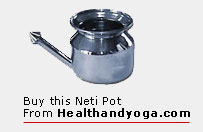 |
 |
 |
 |
 |
||||||
|
|
|
|
|
|||||||
|
|
|
|
|
|
|
|
|
|||
|
|
|
|
|
|
|
|
|
|
|
|
Jala & Sutra Neti Instructions
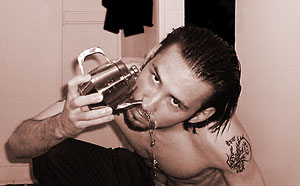
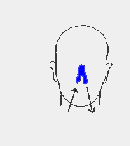 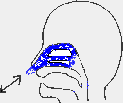
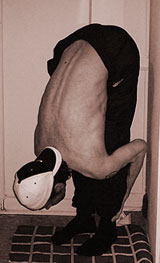 Drying the nose properly is a very important part of the practice. Never
neglect to do this part properly. People with high blood pressure should be
careful of this part. If dizziness results when draining the nose, drying should
only be done standing upright.
Drying the nose properly is a very important part of the practice. Never
neglect to do this part properly. People with high blood pressure should be
careful of this part. If dizziness results when draining the nose, drying should
only be done standing upright.
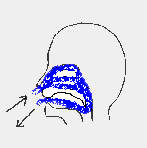 The second stage of Jala Neti is actually called Vyutkrama Kapalbhati, or
sinus bellowing. It�s a more advanced and powerful practice, hence one should
first master the simpler version of Stage 1. This stage of Neti should be
supervised by a teacher on your first few attempts.
Whilst the water is running through from one nostril to the other, it is
gently sniffed backwards and spat out of the mouth. Although not dangerous.
one should not swallow any water when sniffing backwards. When doing
Vyutkrama Kapalbhati, first one potful of water is done as per the Stage 1
version, and then a second potful is done in this more advanced way. In this
case, it is not necessary to dry the nose fully between Stages 1 and 2. Extra
care must be taken to dry the nose properly after Stage 2, as more water
floods the nasal passages and may cause irritation for some time if not
completely dried out. Vyutkrama Kapalbhati Neti works more on clearing out
the posterior sinus passages which Stage 1 does not reach and is even more
effective than Stage 1 for post nasal drip, sinusitis, snoring, chronic catarrh,
thyroid imbalances, coughs and throat problems.
The second stage of Jala Neti is actually called Vyutkrama Kapalbhati, or
sinus bellowing. It�s a more advanced and powerful practice, hence one should
first master the simpler version of Stage 1. This stage of Neti should be
supervised by a teacher on your first few attempts.
Whilst the water is running through from one nostril to the other, it is
gently sniffed backwards and spat out of the mouth. Although not dangerous.
one should not swallow any water when sniffing backwards. When doing
Vyutkrama Kapalbhati, first one potful of water is done as per the Stage 1
version, and then a second potful is done in this more advanced way. In this
case, it is not necessary to dry the nose fully between Stages 1 and 2. Extra
care must be taken to dry the nose properly after Stage 2, as more water
floods the nasal passages and may cause irritation for some time if not
completely dried out. Vyutkrama Kapalbhati Neti works more on clearing out
the posterior sinus passages which Stage 1 does not reach and is even more
effective than Stage 1 for post nasal drip, sinusitis, snoring, chronic catarrh,
thyroid imbalances, coughs and throat problems.Stage 2 (b) 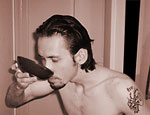 Inhale the water through each nostril separately than spat out of the mouth
Than do both simultaneously
Inhale the water through each nostril separately than spat out of the mouth
Than do both simultaneouslyDo not swallow, Dry the nose completely to avoid infection!!! Stage 3 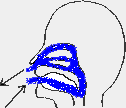 The third stage or method is a little more difficult and advanced again.
This is called Sheetkrama Kapalbhati. Here the warm salty water is taken in
through the mouth and snorted out the nose. This is quite tricky at first and
may be a little uncomfortable in the beginning. The benefits are similar yet
stronger than the other forms of Neti. It is done after a potful of Stages 1 & 2.
Again care must be taken to dry the nasal passages properly, and again, this
stage of Neti should be supervised by a teacher on the first few attempts.
The third stage or method is a little more difficult and advanced again.
This is called Sheetkrama Kapalbhati. Here the warm salty water is taken in
through the mouth and snorted out the nose. This is quite tricky at first and
may be a little uncomfortable in the beginning. The benefits are similar yet
stronger than the other forms of Neti. It is done after a potful of Stages 1 & 2.
Again care must be taken to dry the nasal passages properly, and again, this
stage of Neti should be supervised by a teacher on the first few attempts.Dugdha Neti - Neti with Milk Using milk in the Neti pot, pre-warmed to body temperature, is suitable for those who may suffer chronic nose bleeds or those who initially find intense irritation from the use of salty water. Milk Neti can be done in instances where airborne chemicals or particles have already stripped and/or irritated the nasal lining, for example after sanding plaster or fibreglass. It is best done after a normal pot of warm salty water of Stages 1 and 2. The milk does not need to flow through from one side to the other for half a pot as in the water methods. It only fills the ingoing nostril and is then withdrawn. Once from each side is sufficient. Milk Neti should not be done without qualified advice for your specific problem, and even then, it should not be done excessively. Sutra Neti - Nasal Cleansing Using a Cord 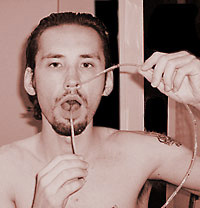 This is a very effective method of keeping the nasal passages open to
their fullest capacity. Sutra Neti is performed by passing a cord made of cotton
threads or a rubber catheter into the nose through one nostril and then out via
the mouth. The cord is gently pulled to and fro for some time, removed and
then threaded through the other nostril and out the mouth again. With practise,
the cord can be passed in one nostril and out the other nostril. Sutra Neti can
be of great benefit, and is highly recommended, for those who may have been
trying Jala Neti for a while and who find that most times the same one nostril is
more blocked than the other. They may have some kind of fleshy obstruction
such as cartilage obstructing the nasal passages. Short of a medical
operation, Sutra Neti is a viable alternative for removing such blockages.
Firstly one should try to succeed with the 3 forms of Jala Neti using water, and
if this fails to clear blockages, a proper medical examination should be made
of the nose, and the cause of structural blockage ascertained. Sutra Neti
should then be learned under the guidance of an experienced teacher.
This is a very effective method of keeping the nasal passages open to
their fullest capacity. Sutra Neti is performed by passing a cord made of cotton
threads or a rubber catheter into the nose through one nostril and then out via
the mouth. The cord is gently pulled to and fro for some time, removed and
then threaded through the other nostril and out the mouth again. With practise,
the cord can be passed in one nostril and out the other nostril. Sutra Neti can
be of great benefit, and is highly recommended, for those who may have been
trying Jala Neti for a while and who find that most times the same one nostril is
more blocked than the other. They may have some kind of fleshy obstruction
such as cartilage obstructing the nasal passages. Short of a medical
operation, Sutra Neti is a viable alternative for removing such blockages.
Firstly one should try to succeed with the 3 forms of Jala Neti using water, and
if this fails to clear blockages, a proper medical examination should be made
of the nose, and the cause of structural blockage ascertained. Sutra Neti
should then be learned under the guidance of an experienced teacher.Before and after usage it is advisable to rinse the string in warm water (or in specialized cases medicated oils). Then place straight to dry. In case of deviated septum. polyps, or other diseases of the nose consult your physician or yoga therapist. The string is slowly, gently, and with conscious feeling (non-mechanically) inserted along the nasal cavity floor without any pain. The nasal cavity is like a long cave which narrows at the roof and is widest at the floor, thus keep the string pointed toward the back of the throat, slightly downward, and slightly medial (inward) so that it will smoothly slide thru the widest passageway toward the inside back opening of the nose. The goal being that it pass through the valve (swollen lip) at the root of the nose into the upper back of the throat where it can be grabbed by the index and middle fingers of the opposite hand (forming a tong-like appendage) and then pulled through after a gentle massage by pulling back and forth on the string a few times (as long as it is comfortable and invigorating). Under no circumstances should pain be experienced during the insertion. If pain occurs, it is a sign of going too fast, the string has become pointed in the wrong direction, and/or is caught up against the nasal wall, or some other obstruction exists. In this case back off the pressure immediately and twist the string in one direction or the other until a clear unobstructed passage through the cave is found. Soon the misty and mysterious dark cave will become a bright and clear one. It is helpful to smoothe and straighten the tip of the string while maintaining a slightly downward orientation of the tip throughout the insertion, so that when the tip goes under the medial bottom lip of the nasal-pharyngeal valve at the entrance to the throat, it points downward toward the mouth. It is not necessary to grab the string with the fingers and pull it back and forth through the nose. 99% of the benefit is obtained by simply passing the string up to and through this nasal-throat valve while gently massaging the nasal membranes which reflex back to the powerful group of nerves which serve in common the entire cranium. Inserting the fingers to grab the end of the string or even the end of the string itself touching the back of the throat can trigger a gag reflex with some. Going slowly and breathing consciously and fully helps. The entire procedure can take less than ten seconds after a little practice. Some people can perform this cleansing activity (kriya) completely on the very first try, while others may take up to a month or longer. At first allow 5 minutes or more with a good supply of tissues handy, if a copious mucous flow is activated. Take your time, very slowly and gently easing the string forward, enjoying its' cleansing effects, and always breathing deeply. It is normal to feel tickled and to sneeze much at first and to eliminate copious mucous from the sinus so have handkerchiefs or tissues handy. As the mucous membranes, nerves, glands, organs, and tissues of the nose, throat, ears, eyes, sinuses, and cranium become tonified, stimulated, invigorated, and purified the body's reaction becomes less dramatic. Sutra Neti is one of the most powerful and beneficial, yet one of the most simple, of the Hatha Yoga shat karmas. It is best performed soon after rising in conjunction with the rest of the morning cleansing activities. For a more detailed information read Jala Neti Booklet.pdf |
| Copyright @ 2003-2007 The Yoga-Age.com All rights reserved. |
